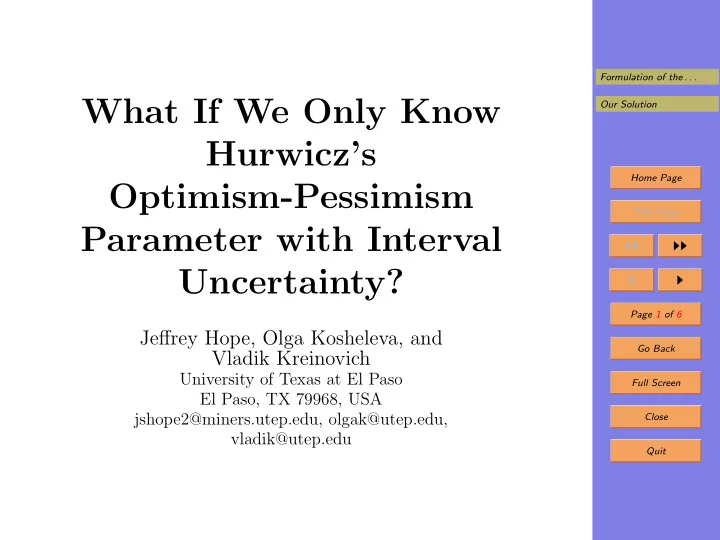

Formulation of the . . . What If We Only Know Our Solution Hurwicz’s Home Page Optimism-Pessimism Title Page Parameter with Interval ◭◭ ◮◮ Uncertainty? ◭ ◮ Page 1 of 6 Jeffrey Hope, Olga Kosheleva, and Go Back Vladik Kreinovich University of Texas at El Paso Full Screen El Paso, TX 79968, USA jshope2@miners.utep.edu, olgak@utep.edu, Close vladik@utep.edu Quit
1. Formulation of the Problem Formulation of the . . . • In many practical situations, we do not know the exact Our Solution consequences of each possible action. • As a result: Home Page – instead of single utility value u , Title Page – we can characterize each possible action by the in- terval [ u, u ] of possible utility values. ◭◭ ◮◮ ◭ ◮ • In such cases, decision theory recommends an alterna- tive for which the following combination is the largest: Page 2 of 6 α · u + (1 − α ) · u = u + α · ( u − u ) . Go Back Full Screen • The parameter α is known as Hurwicz’s optimism- pessimism parameter. Close Quit • It may be different from different people.
2. Formulation of the Problem (cont-d) Formulation of the . . . • The value α = 1 corresponds to absolute optimists. Our Solution • The value α = 0 describes a complete pessimist. • Values between 0 and 1 describe reasonable decision Home Page makers. Title Page • The parameter α needs to be determined based on a ◭◭ ◮◮ person’s preferences and decisions. ◭ ◮ • Often, in different situations, the decisions of the same person correspond to different values α . Page 3 of 6 • As a result, instead of a single value α , we have the Go Back whole range [ α, α ] of possible values. Full Screen • In this case, how should we make decisions? Close Quit
3. Our Solution Formulation of the . . . • For each α ∈ [ α, α ], the interval [ u, u ] is equivalent to Our Solution the value u + α · ( u − u ) . • This expression is monotonic in α . Home Page Title Page • So, in general, the original interval the interval [ u, u ] is equivalent to the following range of possible values ◭◭ ◮◮ ◭ ◮ [ u 1 , u 1 ] = [ u + α · ( u − u ) , u + α · ( u − u )] . Page 4 of 6 • Similarly, the interval [ u 1 , u 1 ] is equivalent to Go Back [ u 2 , u 2 ] = [ u 1 + α · ( u 1 − u 1 ) , u 1 + α · ( u 1 − u 1 )] . Full Screen • We can repeat this construction again and again: Close [ u k +1 , u k +1 ] = [ u k + α · ( u k − u k ) , u k + α · ( u k − u k )] . Quit
4. Our Solution (cont-d) Formulation of the . . . • Reminder: Our Solution [ u k +1 , u k +1 ] = [ u k + α · ( u k − u k ) , u k + α · ( u k − u k )] . • At each step, the width of the original intervals de- Home Page creases by the factor α − α : Title Page u k +1 − u k = ( α − α ) · ( u k − u k ) . ◭◭ ◮◮ • Thus, by induction, we conclude that: ◭ ◮ u k − u k = ( α − α ) k · ( u − u ) . Page 5 of 6 Go Back • So, Full Screen u k +1 = u k + α · ( u k − u k ) = u k + α · ( α − α ) k · ( u − u ) . Close • Hence, Quit u k = u + α · ( u − u ) + . . . + α · ( u − u ) · ( α − α ) k .
5. Our Solution (cont-d) Formulation of the . . . • Here, u k ≤ u k +1 ≤ u k +1 ≤ u k and u k − u k → 0. Our Solution • Thus, in the limit, the intervals [ u k , u k ] tend to a single point Home Page u = u + α · ( u − u )+ α · ( u − u ) · ( α − α )+ α · ( u − u ) · ( α − α ) 2 + . . . Title Page • The corresponding geometric progression adds to ◭◭ ◮◮ α u + α · ( u − u ) for α = ◭ ◮ 1 − ( α − α ) . Page 6 of 6 • This is the desired equivalent value of α for the case Go Back when we know α with interval uncertainty. Full Screen • This is how we should make decisions in this case. Close Quit
Recommend
More recommend